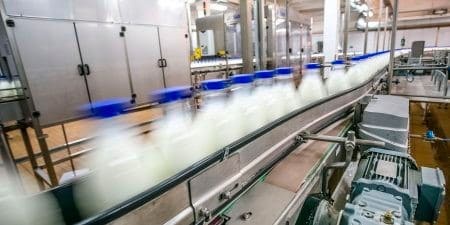An industrial chiller protects processing equipment despite costing a small fraction of most of these facilities. It also increases production, specifically enhancing accuracy and speed of production in food, beverage, and pharmaceutical among other industries. Therefore, it is a no brainer that the equipment should be sized properly to perform these duties to perfection. Understanding the various factors that affect chiller performance lays the foundation for correct sizing.

Fig 1: Process Cooling in the Beverages Industry
What are the essential chiller sizing factors?
One chiller size cannot cater for all cooling loads. Some processes require little fluid while others cannot survive without high flow rates. Similarly, cooling fluids are very choosy when it comes to ambient conditions. Customer preferences are also vital. When you look at these and many other factors, you realize the importance of systematic chiller sizing process.
1. An ideal fluid
What fluid will you use for the process? This can be tricky considering that the fluid should be suitable in terms of both compatibility and performance. It is important to consider how well the fluid will perform in light of long-term integrity of the system. A corrosion inhibitor is a valuable inclusion as it protects the metallic parts of the chiller from early degradation. If a process fluid cannot harbor this inhibitor, you might need to pick another fluid. Also important are thermal properties of the fluid. What are the freezing and boiling points? Does the fluid have suitable viscosity? Answering such questions will help determine the performance of the fluid under different environments. For fluid temperatures above 4 ºC, usually water is the preferred fluid due to its good thermal and physical-chemical properties. However, for lower temperatures water cannot be used as we will be very close or below the freezing point. For this cases, usually, a mixture of water and glycol is used for chillers. This combination working in a temperature range of – 25°C to 80°C.
2. Suitable Ambient Air Conditions
You do not want to ignore the ambient conditions when you are sizing the chiller. The performance of any chiller is affected by ambient temperature. When ambient dry bulb or wet bulb temperatures increase, the condensing temperature increase so the chiller power consumption is higher. Ambient temperature has also some effect on the electronics, compressors and pumps and other equipment temperature sensitive. Increased ambient temperature combined with heat generated during operation can mean shorter lifespan for these components. Think about the highest temperature at which chiller components can work normally.
3. Carefully determined chiller cooling capacity
Calculating the cooling load is necessary to size chillers correctly. The formula below will help determine the cooling capacity required. kW = 4.186 x m 3/h x Temperature Difference (delta T) / 3.6 BTU/ hour = 500 x GPM x Temperature Difference (delta T) To measure temperature difference, use a thermometer or a thermocouple. These readings should be taken at the water inlet and exit points and then the difference computed. Flow rate of water is taken at outlet line of the equipment using a flow meter. Use the above formula for all the equipment that need cooling and add the results. With the total BTU or kW, you can now calculate the tons of cooling needed using this other formula. Tons o refrigeration = kW / 3.517 # Tons of refrigeration = (BTU/hr) / (12,000)
Reasons to size industrial chiller correctly
Poor chiller sizing is a common problem in industries. This can be through either oversizing or undersizing. Instances of oversized chillers are common because facility managers often expect cooling loads to increase with time. However, oversizing the cooling plant will lead to an unnecessary increase in the capital cost. Moreover, the cooling plant will work at partial loads most of the hours of the year. Eventually, this eats into the annual operating efficiency of the facility. The results of using an undersized industrial chiller are obvious and can have detrimental effects. If the unit is undersized, you can be sure it will not be able to offer sufficient cooling at full load conditions. Expert help is often the answer for these types of projects because getting it wrong can mean huge losses. ARANER offers a wide range of chillers. Each unit comes with all the components necessary for easy installation and efficient performance. As you would expect, the company has a highly talented and knowledgeable team of experts. In case you are having problems sizing your chiller, you can initiate a discussion here for the most professional assistance.










